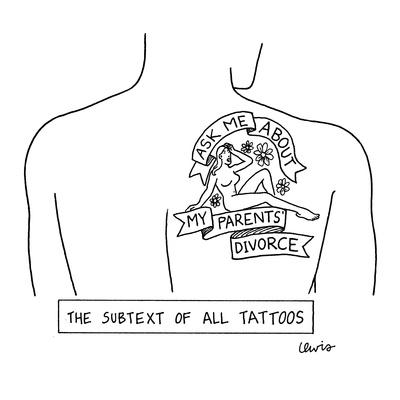![]() Commenter slumber_j points to this New Yorker cartoon about "The subtext of all tattoos:" "Ask me about my parents' divorce."
Commenter slumber_j points to this New Yorker cartoon about "The subtext of all tattoos:" "Ask me about my parents' divorce."
A related subtext might be: "I come from a long line of rash decisionmakers." On women, tattoos often seem to imply: "Pay attention to me because I, obviously, make poor choices, so you might get lucky."
Here's a recent Australian study of tattoo psychodemographics:
Despite recent increases in the popularity of tattooing, little is known about the prevalence and characteristics of adults who have ever been tattooed. We investigated demographic and behavioral correlates of ever getting tattooed in an adult population.
Methods
Computer-assisted telephone interviews were completed by a representative sample of 8656 men and women ages 16–64 years in Australia.
Results
A total of 14.5% of respondents had ever been tattooed, and 2.4% of respondents had been tattooed in the year before the interview. Men were more likely than women to report a tattoo, but the highest rates of tattooing were found among women in their 20s (29.4%). Men and women ages 20–39 were most likely to have been tattooed, as were men with lower levels of education, tradesmen, and women with live-out partners. Tattooing was also associated with risk-taking behaviours, including smoking, greater numbers of lifetime sexual partners, cannabis use (women only) and ever having depression (men only).
Conclusions
Tattooing has increased in popularity during the past decade. Yet tattoos still appear to be a marker for risk-taking behavior in adults.
And from a Pew Center study:
How People Feel About Their Tattoos
Total percentage of people with tattoos who say their tattoo makes them feel rebellious: 29 %
Percentage of people with a tattoo that say it makes them feel more sexy: 31 %
Percentage of people with tattoos who say their tattoo makes them feel more intelligent: 5 %
Conversely, in the century or so after Darwin, it was fashionable in Europe to worry that, in essence, bourgeois family formation selected so much for sexual restraint that the life force, as it were, might be getting bred out among the upper orders. Galton, for example, famously pointed out that the richest heiresses, for whom the most dynamic men competed, tended to be the only child of only children: i.e., from generations of not very fertile couples.













